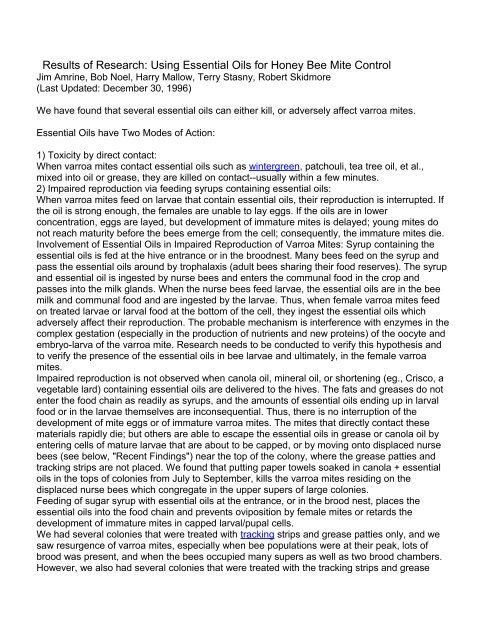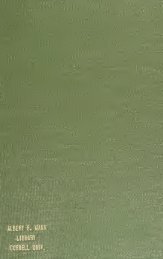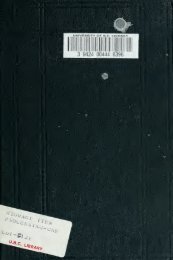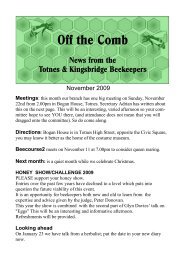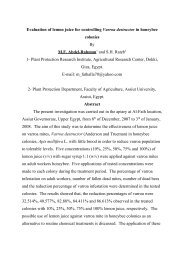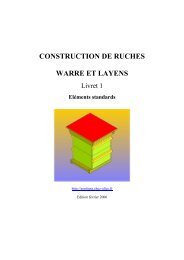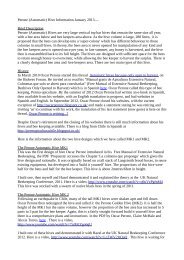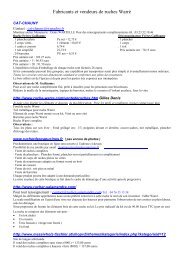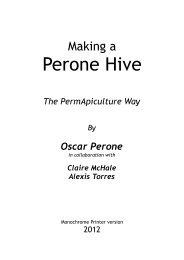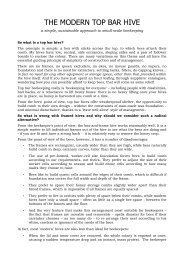Results of Research: Using Essential Oils for Honey Bee ... - BioBees
Results of Research: Using Essential Oils for Honey Bee ... - BioBees
Results of Research: Using Essential Oils for Honey Bee ... - BioBees
Create successful ePaper yourself
Turn your PDF publications into a flip-book with our unique Google optimized e-Paper software.
has a very smooth finish allowing an even coverage and it is too hard <strong>for</strong> the bees to chew up orremove; masonite or other similar material could be used just as well.4). Paper inserts at top <strong>of</strong> hive: For control <strong>of</strong> varroa mite on displaced nurse bees (seecomments above), we use 5.5 cc’s <strong>of</strong> wintergreen per cup <strong>of</strong> canola oil; we put this solution intoa honey bear (used as a squeeze bottle) and apply several lines <strong>of</strong> wintergreen oil mixture inboth directions on a paper towel so that the towel is saturated; the towel is then placed under theinner cover or in the upper supers where displaced nurse bees congregate. The bees chew it upand remove it in a week or so. These are replaced as needed to treat the varroa mites trying toavoid the other treatments. Be careful! Do not get the oil-wintergreen mixture directly onto thequeen.Notes About Grease Patties:1) a recent author stated that grease patties had no adverse effect on tracheal mites whenadministered to his colonies; the paper stated that the patties were purchased commercially. Becertain that the grease patties you make or buy contain plenty <strong>of</strong> grease or vegetable oil. It is thefree oil or grease that appears to suffocate tracheal mites and probably also, varroa mites. Webelieve that this physical suffocating function is enhanced or synergized by the essential oils.2). Several beekeepers have stated that they have used powdered or confectioner’s sugar inplace <strong>of</strong> granular sugar, or even replaced sugar with honey; some have also added canola oil tothe patties to make them s<strong>of</strong>ter and easier to apply with an ice cream scoop. The bees takethese s<strong>of</strong>ter patties more rapidly; and, if made with honey, the essential oils may enter into thefood chain <strong>of</strong> the bee larvae and thus impair development <strong>of</strong> the varroa mites. We plan to try toexamine this question in next year’s research.Conversion Factors: (go to the attached file called "measures")About <strong>Essential</strong> <strong>Oils</strong>: (go to the attached files, "oils" and "chemical")Safety in <strong>Using</strong> <strong>Essential</strong> <strong>Oils</strong>: (go the the attached file, "safety")Varroa Mite Assessment: You can place a detector board on the bottom <strong>of</strong> the hive incombination with patties and a tracking strip to obtain a count <strong>of</strong> varroa mites within 24 to 48hours. In our tests the essential oils killed more mites than Apistan.We make detector boards by making light wooden frames, a little smaller that the bottom boardarea, by stapling thin wooden molding strips at their corners to 1/8 inch hardware cloth (wirescreen); we then cut "freezer paper" (available in grocery stores in the U.S.; it has large size, isfairly thick, white and durable) to size, spray one side with "PAM" (a non-stick spray <strong>for</strong> fryingpans), and then staple it to the wooden strips on the side opposite the hardware cloth. Thesecan be assembled in a few minutes at a cost <strong>of</strong> $2 U.S. or less. Many bee supply housesprovide them at a fairly expensive price.Timing <strong>of</strong> Treatments:We have found that colonies, heavily infested with varroa mites in August, September andOctober, probably can not be saved. The treatments with grease patties and tracking strips willkill mites, but it is too late in the season to allow rearing <strong>of</strong> new, uninfested brood which wouldenhance survival <strong>of</strong> the colony. But, more importantly, even if all varroa mites are killed afterheavy infestation, the bees may still die from the acute bee paralysis virus, Kashmir virus orother viruses transmitted earlier by the varroa mites.However, strong, healthy colonies--free <strong>of</strong> mites in early September, but later overwhelmed byan influx <strong>of</strong> lost bees and mites from dying feral colonies or from untreated neighboringcolonies--can be protected and saved by using the grease patties + essential oils throughout the
fall and winter. Since little or no brood will be available as shelters, the contact <strong>of</strong> the grease andessential oils will kill virtually all <strong>of</strong> the mites--be<strong>for</strong>e they are able to transmit the viruses.We recommend: 1) That grease patties + essential oils (and other medicaments as desired) bekept on the hives throughout the winter. 2) That grease patties and essential oils be kept onhives throughout the rest <strong>of</strong> the year (be sure no other medicaments are used). 3) Whentemperatures are warm enough to allow flight, that colonies be treated with syrups containingessential oils delivered to the brood area (e.g., boardman feeders with 1/2 gallon jars). 4) Whentemperatures are warm enough to allow flight, that tracking strips be used to administeressential oils to the bees, especially during honey flows.Recent Findings:In colonies treated with tracking strips at the entrance and grease patties over the broodchambers, the varroa mites were able to escape treatment. Displaced nurse bees, which gatherunder the inner cover, were used as a hiding place by the mites. We treated this group <strong>of</strong> beesand mites by putting a piece <strong>of</strong> paper towel, treated with canola oil and winter-green, just underthe inner cover. Very few mites were found on these bees after treatment.The tracking strips and grease patties are lethal to exposed mites (those on adult bees orwalking over frames), but the mites can escape these treatments by going into brood cells aboutto be capped. There were very few mites on adults in treated colonies, but the mites werereproducing at normal levels in drone cells and worker brood cells (especially in August andSeptember). The few remaining drone cells had lots <strong>of</strong> mites in them (13 Sep 96). We concludedthat the essential oils in tracking strips and grease patties do not enter the food chain sufficientlyto impair mite development.The colonies that were fed syrup with essential oils, in addition to using tracking strips andgrease patties, were virtually free <strong>of</strong> varroa mites, without using Apistan.Robbing can be greatly reduced by making an entrance cleat that surrounds the boardmanfeeder and provides an entrance at the other end <strong>of</strong> the cleat:Diagram <strong>of</strong> a wooden cleat made to fit in the entrance <strong>of</strong> a hive--dimensions will vary.Large colonies with many supers and lots <strong>of</strong> space made mite control more difficult: thetreatments were too diluted by the volume <strong>of</strong> space and number <strong>of</strong> dispersed bees. There<strong>for</strong>e,we recommend that beekeepers remove honey supers as soon as possible and reduce coloniesto 1 or 2 brood chambers, at most.In some <strong>of</strong> our colonies, grease patties containing spearmint oil were propolized; but not thosepatties made with wintergreen, tea tree or patchouli oils.We believe that during the late fall and early winter the varroa mite is very susceptible to controlby essential oils due to the <strong>for</strong>mation <strong>of</strong> a cluster and to the lack <strong>of</strong> brood. By treating hives withthe grease patties (and tracking strips and syrups if weather is warm enough) containingwintergreen, tea tree and/or patchouli oils, and making sure the treatments are near the cluster,then the varroa mites will have no place to hide and all can be killed. (No brood cells will beavailable as shelters.)
Queens: A potential problem may be that queens on mating flights may have their pheromonemasked or may become somewhat disoriented by essential oils. We recommend that theessential oil treatments be removed from the hives when queen rearing and mating is takingplace. Care must be taken to avoid getting canola with essential oil directly onto the queen.Drones: We found that large numbers <strong>of</strong> drone cells provide protection to the varroa mites andare definitely the source <strong>of</strong> most breeding varroa mites. Consequently, we recommend that theamount <strong>of</strong> available drone cells be kept to a minimum; be sure to remove and replace old combcontaining lots <strong>of</strong> irregular drone cells. (See the literature <strong>for</strong> techniques using periodic droneremoval to reduce varroa mites).Comments on Varroatosis:There are two <strong>for</strong>ms <strong>of</strong> varroatosis (infestation <strong>of</strong> bee colonies by the varroa mite):1) Epidemic Varroatosis: This <strong>for</strong>m <strong>of</strong> varroatosis occurs when the disease spreadsuncontrolled through feral colonies, and/or through untreated apiaries in a large area. In this<strong>for</strong>m <strong>of</strong> the disease, "rapid development" <strong>of</strong> varroa mites is seen accompanied by the complex <strong>of</strong>ailments known as PMS (parasitic mite syndrome) or bee PMS (see papers by Shimanuki andHung), followed by sudden collapse and death <strong>of</strong> colonies. What is happening? Dying feralcolonies, or dying apiaries, send <strong>for</strong>th lost bees that are carrying large numbers <strong>of</strong> varroa mites.[Or, robber bees may be picking up large numbers <strong>of</strong> mites from dying feral colonies.] Thus a"queenright" colony is suddenly invaded by large numbers <strong>of</strong> phoretic, parasitic mites. Under"normal" conditions, the mites in a colony do not produce huge numbers in just one or twomonths; sudden increases in mite numbers are the result <strong>of</strong> mass influx <strong>of</strong> bees and mitesdeserting dying colonies. At the same time, the mites, coming from many diverse colonies, haveacquired many different pathogens: agents <strong>of</strong> sac brood, chalk brood, acute bee paralysis virus,kashmir virus, Egypt (de<strong>for</strong>med wing) virus, chronic bee paralysis, etc. The sudden appearanceand spread <strong>of</strong> these pathogens in a colony produces the syndrome called PMS. The colonybecomes very weak and unable to fend <strong>of</strong>f common pests such as wax moth, yellow jackets,etc., and the colony rapidly dwindles and then dies. Epidemic varroatosis was spread intovarious centers throughout the U.S. by migratory beekeepers, who were not aware <strong>of</strong> the degree<strong>of</strong> mite infestations nor <strong>of</strong> the various pathogens being transmitted. This epidemic varroatosishas thus spread throughout the U.S. in a series <strong>of</strong> expanding circles in nearly every state; thedisease reached Bob Noel’s colonies in summer 1995, when he began his research withessential oils. The most dramatic results <strong>of</strong> effective research will be evident when applied tocolonies suffering from epidemic varroatosis.2) Chronic Varroatosis: Once the epidemic has passed (as shown by the loss <strong>of</strong> all feralcolonies and the loss <strong>of</strong> all colonies in apiaries that were not treated), the varroatosis will take its"normal" chronic <strong>for</strong>m: much slower rate <strong>of</strong> development <strong>of</strong> mite populations in hives, which if leftuntreated, will eventually succumb in 3 or 4 seasons. Also, very few <strong>of</strong> the other virus diseaseswill be seen, which produced the PMS symptoms described above. Treatments using Apistan,<strong>for</strong>mic acid, etc., will prevent the mites from overwhelming colonies. Thus, here in the U.S.,beekeepers will enter the phase that the Europeans have been experiencing <strong>for</strong> the past severalyears. This milder <strong>for</strong>m <strong>of</strong> varroatosis causes some beekeepers to erroneously believe thatvarroatosis is not such a severe pest <strong>of</strong> honey bees, and that the terrible scourge that decimatedbee colonies must have been due to other causes. Despite its less severe expression, chronicvarroatosis is an insidious disease capable <strong>of</strong> the eventual demise <strong>of</strong> all European <strong>Honey</strong> <strong>Bee</strong>Colonies.
Comments on Natural Resistance to Varroatosis:There are many papers in the literature that remark on "bee resistance" to varroa mites, or onregions and countries where the varroa mite, although present, is not a problem. We believe thatin many <strong>of</strong> these cases that essential oils in nectars (and/or pollens?) collected in and aroundthe colonies had a suppressive effect on varroa mite reproduction. None <strong>of</strong> the papersconsidered the possibility that a component <strong>of</strong> the bees’ diet (from nectar or pollen) or frompropolis may have adversely affected the development <strong>of</strong> the varroa mites. A series <strong>of</strong>appropriate experiments in Brazil, et al. locations where this was observed, would be able todetermine if this indeed is what causes the large numbers <strong>of</strong> "sterile" or non-reproducing varroamites found in these colonies.A recent report <strong>of</strong> varroa mites on Apis cerana in Papua New Guinea mentions that none havebeen found in nearby colonies <strong>of</strong> Apis mellifera, suggesting that these colonies may haveresistance to the varroa mites. However, we believe that the "jump" made by Varroa jacobsonifrom Apis cerana (its original, natural host) to Apis mellifera may be a comparatively rare event.Maybe such a jump occurs only once or twice per decade: perhaps our current varroa miteproblem comes to us from a jump that occurred in Japan last century. This possibility could beexperimentally investigated by per<strong>for</strong>ming a series <strong>of</strong> transfer experiments--especially onewhere varroa mites from varroa-infested Apis mellifera are transferred to these supposedlyresistant colonies in an experimental setting (e.g., on some small Island distant from Papua NewGuinea). Similar experiments should be conducted in Japan and in China where A. cerana andA. mellifera are artificially sympatric.The possibility <strong>of</strong> European <strong>Honey</strong> <strong>Bee</strong>s in the U. S. developing hygienic behavior to removemites has been mentioned in several papers. We believe that the evidence suggests thereapparently are no populations that exhibit this behavior. Our conclusion is based on the fact thatvirtually all feral bees have been destroyed by the varroa mite. If there had been hygienicbehavioral types present, they would be evident by now. We also believe that the Eastern U. S.had considerable diversity among the <strong>for</strong>merly immense feral bee populations. For decadesbeekeepers bought different kinds <strong>of</strong> bees originally derived from many parts <strong>of</strong> Europe andCentral Asia (eg., Italians, Dark Germans, Carniolans, Caucasian, and many types <strong>of</strong> hybridssuch as Starlines, Midnights, Buckfast, et al.)--and from these colonies, swarms have issued allthrough the eastern U. S. and produced the feral colonies that were abundant until varroa mitearrived. We believe that the enormous diversity <strong>of</strong> these feral colonies throughout the U.S. wouldhave contained the genes <strong>for</strong> hygienic behavior, if such genes were available. But since virtuallyall feral bees are now gone, it is apparent that even this extensive diversity was not sufficient toprovide any meaningful resistance to the varroa mite. However, we need to be alert <strong>for</strong> thepossibility that somewhere, in some corner <strong>of</strong> the <strong>for</strong>merly vast feral populations, one suchresistant hygienic colony or population managed to survive.EPA Exemption <strong>of</strong> <strong>Essential</strong> <strong>Oils</strong>:We learned recently that EPA has exempted certain active ingredients from the requirements <strong>of</strong>FIFRA (Federal Insecticide, Fungicide and Rodenticide Act) including some essential oils; thisin<strong>for</strong>mation can be found in the Federal Register, Vol. 61, No. 45:8876-8879, Weds., Mar. 6,1996 ("Exemption <strong>of</strong> certain pesticide substances"); materials listed include cinnamon oil,citronella oil, lemongrass oil, mint and mint oil [eg., Patchouli oil], peppermint oil, etc. EPA furtherstated that the inert substances in Fed. Reg. Vol. 61, No. 45 can be added to the activeingredients listed in Fed. Reg. Vol. 59, No. 187:49400-49401, Weds., Sep 28, 1994 ("Inertingredients in Pesticide Products"), including cloves, mineral oil, parafin wax, wintergreen oil,
etc. The label <strong>for</strong> exempted products must list the name and percentage (by weight) <strong>of</strong> eachactive ingredient and the name <strong>of</strong> each inert ingredient, and must not contain any false ormisleading statements (40 CFR Art. 156.10, 1 July 1994). Many states require some <strong>for</strong>m <strong>of</strong>state labeling such as "Attention: this product is a pesticide which is exempt from federal safetytesting requirements. State registration does not imply safety or efficacy. User assumes fullliability <strong>of</strong> use." Contact your state pesticide <strong>of</strong>fice <strong>for</strong> their requirements.Notes about tracheal mites:We checked Bob’s colonies <strong>for</strong> tracheal mites by collecting older <strong>for</strong>agers: those that havefrayed wings and a bald thorax. We removed their heads and first pair <strong>of</strong> legs and examined thetracheal trunks that are visible inside the resulting cavity (you may need to peel <strong>of</strong>f the "collar"with <strong>for</strong>ceps on some specimens); infested tracheae could be seen with a hand lens and weredark spotted or uni<strong>for</strong>mly dark. <strong>Results</strong>: in some control colonies (no treatments) 30% hadtracheal mites; in treated colonies, 10% or less had tracheal mites. Since bees are able to driftconsiderable distances, we suspect that some <strong>of</strong> those in our treated colonies may have comein from other, declining feral colonies in the neighborhood (a few feral colonies still remain nearCumberland, but these will probably all disappear by 1997). The older bees give a more reliabletest <strong>for</strong> the presence and extent <strong>of</strong> infestation by tracheal mite. We learned that Britishbeekeepers, up until about 1950, used a bottle <strong>of</strong> wintergreen oil (methyl salicylate) with a wickthrough the top and placed in the bottom <strong>of</strong> their hives to control acarine disease (trachealmites) (courtesy <strong>of</strong> David Eyre, Ontario, Canada). We also learned that Dr. Rennie, around1919-1925, recommended oil <strong>of</strong> wintergreen over the original Frow treatment (safrolnitrobenzene-petrol)as a treatment <strong>for</strong> Isle <strong>of</strong> Wight Disease (acarine disease or tracheal mites)(courtesy <strong>of</strong> Mr. Joe Hemmens, UK).On 23-25 December 1996, four colonies at WVU were examined <strong>for</strong> tracheal mite. Exams <strong>for</strong>tracheal mites were negative in July, August, and September. The colonies were treated withgrease patties and syrups containing wintergreen and tea tree oil in summer and fall. Eight <strong>of</strong> 36bees on 23 December had tracheal mite (22.2%); eggs, larvae, males and females were presentindicating active development <strong>of</strong> the tracheal mites. The sample consisted <strong>of</strong> live and dead beesfrom the front <strong>of</strong> colonies. Each hive was sampled again on 24 December: Hive 1: 0/19 (0 %).Hive 2: 3/17 (17.6%). Hive 3: 3/23(13.04%). Hive 4: 6/21 (28.6%). Overall, the tracheal miteinfestation was 20/116 (17.2%) total (20/97 or20.6% <strong>for</strong> the three infested hives). Three colonies(1,2,4) were treated by shaking warm sugar syrup containing dissolved menthol (1 tsp stockmenthol solution per pint) and canola oil (1 tsp/pint) onto the bees on 30 Dec. 1996: 1/2 pint percluster (ambient temperature = 61 F.) [provide access here to the file "tm.wpd"] The hives will beexamined in January and February to determine tracheal mite infestation.Experimental Treatment: Menthol + Oil <strong>for</strong> Tracheal Mite (Acarapis woodi) ControlUseful Equivalents and Measures <strong>for</strong> Mixing <strong>Essential</strong> <strong>Oils</strong><strong>Essential</strong> oils used to control mites in honey beesGeneral Safety Considerations <strong>for</strong> <strong>Using</strong> <strong>Essential</strong> <strong>Oils</strong>Questions or comments please contact:James W. Amrine, Jr.Division <strong>of</strong> Plant and Soil Sciences,P. O. Box 6108, West Virginia UniversityMorgantown, WV 26505-6108 USATelephone: 304-293-6023E-mail: jamrine@wvnvm.wvnet.edu


